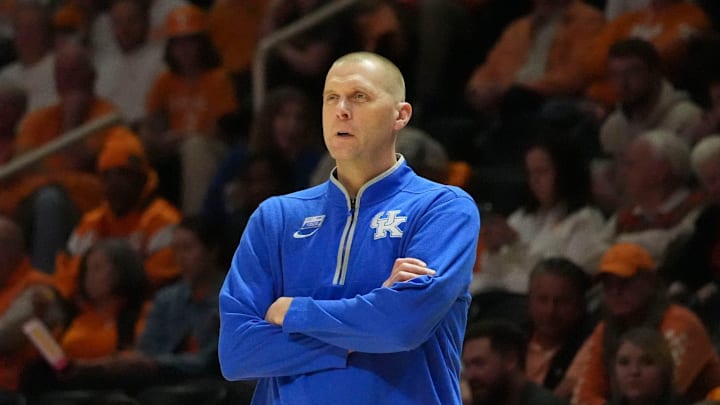The Kentucky Wildcats are a team built for March, but their six losses this season have revealed troubling trends that could spell trouble if not addressed. While Kentucky has the talent to compete with anyone, each defeat has followed a remarkably similar script—cold shooting stretches, costly fouls, and struggles in key moments.
Let's break down the common themes that have haunted the Wildcats in their toughest losses.
Kentucky basketball's kyrptonite list
1. The Cold Streaks Are Real—And Costly
HALF: Alabama leads Kentucky 47-45.
— Wyatt Huff (@Wildcat_wave) January 18, 2025
A three-minute scoring drought during the final minutes has helped Bama take a lead. Both teams cooled off late in the half, but we've still got a fast, fun, high-scoring game. Pretty balanced scoring for the Cats, with Oweh and Williams lead… pic.twitter.com/c0LIRg3zqo
A bad shooting stretch in basketball is inevitable, but Kentucky’s scoring droughts have been absolute momentum killers. Here’s how long the Wildcats went without a field goal in some of their losses:
Ohio State: Nearly 9 minutes without a made field goal
Georgia: 5 minutes with no baskets
Arkansas: 4:43 with no points at all
Vanderbilt: 4:10 with no points or field goals
Clemson: 5:14 without a basket
Even in games where they managed to get to the free-throw line, the Wildcats' offense has sputtered for extended stretches. Against Ohio State, they went almost five full minutes without a single point.
Takeaway: Kentucky needs to find a go-to scorer to stop the bleeding when the shots stop falling. Right now, those cold spells are turning close games into uphill battles.
2. Three-Point Woes in Big Moments
Jaxson Robinson hits his 3rd three! Followed by an Almonor three. Kentucky is now 6/9 from three. Nice. pic.twitter.com/E7d2sFdgGh
— Rare Rookies #BBN (@rarerookies) January 29, 2025
Modern basketball revolves around three-point shooting, and while Kentucky has some sharpshooters, their efficiency from deep has been wildly inconsistent.
Clemson: 7-for-27 (25.9%)
Ohio State: 4-for-22 (18.2%)
Georgia: 6-for-25 (24.0%)
That’s three different games where they shot below 26% from deep—a recipe for disaster when opponents are hitting timely threes (like Arkansas, which buried 13-of-25 threes against them).
Takeaway: The Wildcats don’t need to hit 50% from deep, but they can’t afford to keep shooting themselves out of games when the rim tightens up.
3. Free Throws: The Wildcard for the Wildcats

Free throw shooting should be the easiest fix, yet Kentucky has been unpredictable at the line.
Against Clemson and Arkansas, they shot just over 50%—leaving critical points on the table.
Against Georgia, they hit 78.9%, yet Georgia took 19 more free throws and outscored them by 14 points at the line.
Against Ohio State, they shot 84.4%—but only hit 17 field goals the entire game.
Takeaway: When the shooting gets cold, free throws need to keep them in the game. Right now, that’s not happening consistently enough.
4. Turnovers & Passing Struggles

Kentucky has also struggled with turnover battles and creating easy scoring opportunities.
Against Vanderbilt, they committed 17 turnovers while forcing only 5.
Against Arkansas, they had just 11 assists on 30 made baskets—meaning a lot of tough, individual shots instead of fluid offense.
Against Clemson and Georgia, they finished with fewer assists than their opponents, limiting their ability to create good looks.|
Takeaway: The Wildcats thrive in transition, but sloppy turnovers and stagnant offense have made things harder than they need to be. 14+ turnovers in 3 of 4 games is not a winning strategy.
5. The Fouling Problem
Kentucky will have to learn how to play defense without being called for fouls. pic.twitter.com/8sunB1uz92
— KSR (@KSRonX) January 18, 2025
In close games, free throws can be the difference—and Kentucky has been fouling at an alarming rate.
Georgia shot 38 free throws (compared to Kentucky’s 19).
Clemson, Ohio State, and Alabama all outshot Kentucky at the line.
In every loss outside of Arkansas, Kentucky committed at least 20 fouls—often putting their opponents in the bonus early.
It’s not just about getting to the free-throw line—it’s about keeping the other team off of it. Kentucky can’t afford to keep gifting teams free points when their own offense is struggling.
The Bottom Line: Fix the Fundamentals
Kentucky has all the pieces to make a deep tournament run, and plenty of big time games (remaining schedule). But right now, their inconsistent shooting, scoring droughts, turnovers, and foul trouble are costing them winnable games.
The good news? These are fixable problems. The Wildcats don’t need a complete overhaul—just more discipline in key moments. If they can tighten up these areas, watch out come March. A little more Superman, a little less Clark Kent, fly close to the sun young men.
